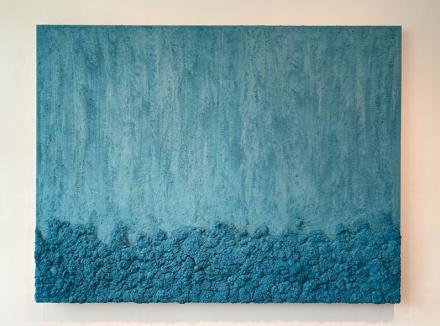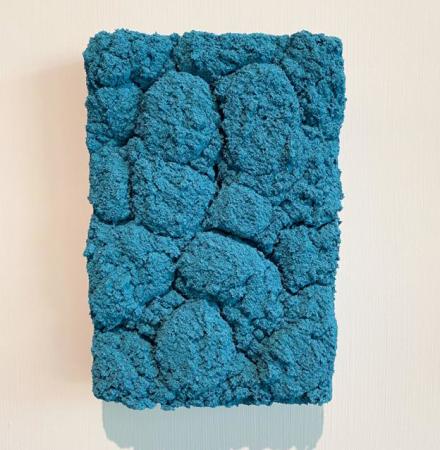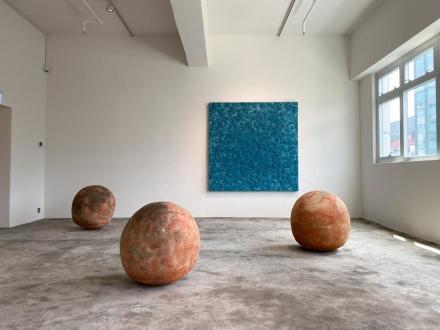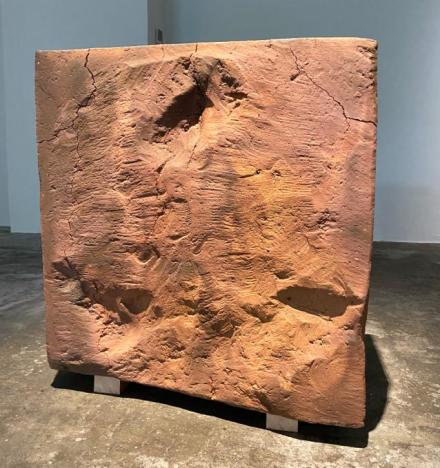
Bosco Sodi, A Thousand Li of Rivers and Mountains (Installation View), via Art Observed
As the city of Hong Kong gradually reopens, galleries are slowly returning to business as usual, with shows returning to their exhibition schedules, albeit slowly and gradually. Among these shows is a quite striking exhibition of new pieces by Mexican artist Bosco Sodi at Axel Vervoodt, incorporating a range of material investigations and variations on his already enigmatic and exploratory processes. Titled A Thousand Li of Rivers and Mountains, the exhibition takes the artist’s own hand and his engagement with traditional Chinese art techniques in equal stride.
 Bosco Sodi, A Thousand Li of Rivers and Mountains (Installation View), via Art Observed
Bosco Sodi, A Thousand Li of Rivers and Mountains (Installation View), via Art Observed
Late last year, Sodi spent two weeks in Hong Kong, creating a body of new works specifically exploring the depths and boundaries of the color turquoise. Drawing particular inspiration from the painter Wang Ximeng’s twelve-meter-long landscape, A Thousand Li of Rivers and Mountains, painted over the course of six months in the year 1113 CE, Sodi drew inspiration from the deep azures and turquoises of the work, and sought to incorporate that same style into his new pieces. Drawing on both macroscopic and microscopic biological forms, the artist twists these compositions into evocative and challenging landscapes in their own right, valleys and clefts of paint that both explore Wang Ximeng’s work and turn its ideas towards a more literal approach to landscape. Rather than drawing on the material as the point of genesis for an exploration of landscape, Sodi turns the material inwards, towards the inherent capacity to create and shape the landscape anew.

Bosco Sodi, A Thousand Li of Rivers and Mountains (Installation View), via Art Observed
In addition to the new series of paintings, the gallery is presenting a selection of Sodi’s clay sculptures, created at the artist’s studio, Casa Wabi, in Oaxaca, Mexico. In these works, the artist extracts raw earth from the ground and combines it with water and sand to form clay. He uses this elemental material, embedded with ancestral significance, to create minimalist sculptures. Once cured, the clay sculptures are fired in a traditional brick kiln with wood, jacaranda seeds, and coconut shells, a process that imbues the sculptures with varied terracotta hues, streaks of green and black, and a multitude of fissures in the surface, giving each cube a unique identity.
 Bosco Sodi, A Thousand Li of Rivers and Mountains (Installation View), via Art Observed
Bosco Sodi, A Thousand Li of Rivers and Mountains (Installation View), via Art Observed
This sense of the elemental and its capacity to create large-scale representations of natural processes offer an echo of Wang Ximeng’s explorations of time and narrative, land and history, bound up in the act of representation. Removing the human aspects of narrative from the image, Sodi allows a similar sense of timeless to persist nevertheless.
— D. Creahan
Read more:
Bosco Sodi: A Thousand Li of Rivers and Mountains [Exhibition]



